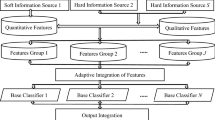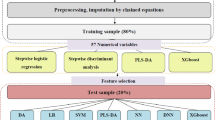Abstract
In this paper, we use random subspace method to compare the classification and prediction of both canonical discriminant analysis and logistic regression models with and without misclassification costs. They have been applied to a large panel of US banks over the period 2008–2013. Results show that model’s accuracy have improved in case of more appropriate cut-off value \(C^*_{ROC}\) that maximizes the overall correct classification rate under the ROC curve. We also have tested the newly H-measure of classification performance and provided results for different parameters of misclassification costs. Our main conclusions are: (1) The logit model outperforms the CDA one in terms of correct classification rate by using usual cut-off parameters, (2) \(C^*_{ROC}\) improves the accuracy of classification in both CDA and logit regression, (3) H-measure and ROC curve validation improve the quality of the model by minimizing the error of misclassification of bankrupt banks. Moreover, it emphasizes better prediction of banks failure because it delivers in average the highest error type II.
Similar content being viewed by others
Notes
The specificity represents the number of the actives banks classified in the group of the actives banks.
The sensitivity represents the percentage of the bankrupt banks correctly classified.
The correct classification rate corresponds to the number of all the banks correctly classified.
References
Adya, M., & Collopy, F. (1998). How effective are neural networks at forecasting and prediction? A review and evaluation. Journal of Forecasting, 17, 481–495.
Altman, E. I. (1968). Financial ratios, discriminant analysis and the prediction of corporate bankruptcy. The Journal of Finance, 23(4), 589–609.
Altman, E. I. (1984). A further empirical investigation of the bankruptcy cost question. The Journal of Finance, 39(4), 1067–1089.
Altman, E. I., & Narayanan, P. (1997). An international survey of business failure classification models. Financial Markets, Institutions & Instruments, 6(2), 1–57.
Avery, R. B., Hanweck, G. A., et al. (1984). A dynamic analysis of bank failures. Board of Governors of the Federal Reserve System (US): Technical report.
Aziz, M. A., & Dar, H. A. (2004). Predicting corporate financial distress: Whither do we stand?. Department of Economics: Loughborough University.
Balcaen, S., & Ooghe, H. (2006). 35 years of studies on business failure: an overview of the classic statistical methodologies and their related problems. The British Accounting Review, 38(1), 63–93.
Balcaen, S., Ooghe, H., et al. (2004). Alternative methodologies in studies on business failure: do they produce better results than the classical statistical methods? Vlerick Leuven Gent Management School Working Papers Series, (16).
Barr, R. S., Siems, T. F., et al. (1994). Predicting bank failure using dea to quantify management quality. Federal Reserve Bank of Dallas: Technical report.
Barth, J. R., Brumbaugh, R. D., Sauerhaft, D., Wang, G. H., et al. (1985). Thrift institution failures: Causes and policy issues. In Federal Reserve Bank of Chicago Proceedings, p 68.
Beaver, W. H. (1966). Financial ratios as predictors of failure. Journal of Accounting Research, 4, 71–111.
Benston, G. J. (1985). An analysis of the causes of savings and loan association failures. Salomon Brothers Center for the Study of Financial Institutions: Graduate School of Business Administration, New York University.
Bilderbeek, J. (1979). Empirical-study of the predictive ability of financial ratios in the netherlands. Zeitschrift fur Betriebswirtschaft, 49(5), 388–407.
Canbas, S., Cabuk, A., & Kilic, S. B. (2005). Prediction of commercial bank failure via multivariate statistical analysis of financial structures: The Turkish case. European Journal of Operational Research, 166(2), 528–546.
Coakley, J. R., & Brown, C. E. (2000). Artificial neural networks in accounting and finance: Modeling issues. International Journal of Intelligent Systems in Accounting, Finance & Management, 9(2), 119–144.
Dabos, M., & Sosa-Escudero, W. (2004). Explaining and predicting bank failure using duration models: The case of argentina after the mexican crisis. Revista de Análisis Económico, 19(1), 31–49.
Dimitras, A. I., Zanakis, S. H., & Zopounidis, C. (1996). A survey of business failures with an emphasis on prediction methods and industrial applications. European Journal of Operational Research, 90(3), 487–513.
Du Jardin, P. (2015). Bankruptcy prediction using terminal failure processes. European Journal of Operational Research, 242(1), 286–303.
Du Jardin, P. (2016). A two-stage classification technique for bankruptcy prediction. European Journal of Operational Research, 254(1), 236–252.
Du Jardin, P., & Séverin, E. (2012). Forecasting financial failure using a kohonen map: A comparative study to improve model stability over time. European Journal of Operational Research, 221(2), 378–396.
Etheridge, H. (2015). Minimizing the costs of using models to assess the financial health of banks. International Journal of Business and Social Research, 5(11), 09–18.
Fitzpatrick, T., & Mues, C. (2016). An empirical comparison of classification algorithms for mortgage default prediction: Evidence from a distressed mortgage market. European Journal of Operational Research, 249(2), 427–439.
Frydman, H., Altman, E. I., & KAO, D.-L. (1985). Introducing recursive partitioning for financial classification: The case of financial distress. The Journal of Finance, 40(1), 269–291.
Gepp, A., & Kumar, K. (2015). Predicting financial distress: A comparison of survival analysis and decision tree techniques. Procedia Computer Science, 54, 396–404.
Hair, J., Black, W., Babin, B., & Anderson, R. (2010). Multivariate data analysis: A global perspective. Upper Saddle River, NJ: Pearson.
Hand, D. J. (2009). Measuring classifier performance: A coherent alternative to the area under the roc curve. Machine Learning, 77(1), 103–123.
Hassan Al-Tamimi, H. A., & Charif, H. (2011). Multiple approaches in performance assessment of UAE commercial banks. International Journal of Islamic and Middle Eastern Finance and Management, 4(1), 74–82.
Jagtiani, J., Kolari, J., Lemieux, C., Shin, H., et al. (2003). Early warning models for bank supervision: Simpler could be better. Economic Perspectives-Federal Reserve Bank of Chicago, 27(3), 49–59.
Jolliffe, I. (2002). Principal component analysis. New York: Wiley.
Keasey, K., & Watson, R. (1991). Financial distress prediction models: A review of their usefulness. British Journal of Management, 2(2), 89–102.
Kolari, J., Caputo, M., & Wagner, D. (1996). Trait recognition: An alternative approach to early warning systems in commercial banking. Journal of Business Finance & Accounting, 23(9–10), 1415–1434.
Kumar, P. R., & Ravi, V. (2007). Bankruptcy prediction in banks and firms via statistical and intelligent techniques: A review. European Journal of Operational Research, 180(1), 1–28.
Lanine, G., & Vander Vennet, R. (2006). Failure prediction in the russian bank sector with logit and trait recognition models. Expert Systems with Applications, 30(3), 463–478.
Lau, A. H.-L. (1987). A five-state financial distress prediction model. Journal of Accounting Research, 25(1), 127–138.
Martin, D. (1977). Early warning of bank failure: A logit regression approach. Journal of Banking & Finance, 1(3), 249–276.
Ohlson, J. A. (1980). Financial ratios and the probabilistic prediction of bankruptcy. Journal of Accounting Research, 18(1), 109–131.
O’leary, D. E. (1998). Using neural networks to predict corporate failure. International Journal of Intelligent Systems in Accounting, Finance & Management, 7(3), 187–197.
Olmeda, I., & Fernández, E. (1997). Hybrid classifiers for financial multicriteria decision making: The case of bankruptcy prediction. Computational Economics, 10(4), 317–335.
Pantalone, C. C., Platt, M. B., et al. (1987). Predicting commercial bank failure since deregulation. New England Economic Review, 15, 37–47.
Sinkey, J. F. (1975). A multivariate statistical analysis of the characteristics of problem banks. The Journal of Finance, 30(1), 21–36.
Sinkey, J. F. (1978). Identifying “problem” banks: How do the banking authorities measure a bank’s risk exposure? Journal of Money, Credit and Banking, 10(2), 184–193.
Tennyson, B. M., Ingram, R. W., & Dugan, M. T. (1990). Assessing the information content of narrative disclosures in explaining bankruptcy. Journal of Business Finance & Accounting, 17(3), 391–410.
Thomson, J. B. (1991). Predicting bank failures in the 1980s. Economic Review-Federal Reserve Bank of Cleveland, 27(1), 9.
Vellido, A., Lisboa, P. J., & Vaughan, J. (1999). Neural networks in business: A survey of applications (1992–1998). Expert Systems with Applications, 17(1), 51–70.
Wong, B. K., Bodnovich, T. A., & Selvi, Y. (1997). Neural network applications in business: A review and analysis of the literature (1988–1995). Decision Support Systems, 19(4), 301–320.
Zavgren, C. V. (1985). Assessing the vulnerability to failure of american industrial firms: A logistic analysis. Journal of Business Finance & Accounting, 12(1), 19–45.
Zhang, G., Patuwo, B. E., & Hu, M. Y. (1998). Forecasting with artificial neural networks: The state of the art. International Journal of Forecasting, 14(1), 35–62.
Zopounidis, C., & Dimitras, A. (1993). The forecasting of business failure: Overview of methods and new avenues. Applied Stochastic Models and Data Analysis, World Scientific Publications, London.
Author information
Authors and Affiliations
Corresponding author
Additional information
This work was achieved through the Laboratory of Excellence on Financial Regulation (Labex ReFi) supported by PRES heSam under the reference ANR-10-LABX-0095.
Rights and permissions
About this article
Cite this article
Affes, Z., Hentati-Kaffel, R. Predicting US Banks Bankruptcy: Logit Versus Canonical Discriminant Analysis. Comput Econ 54, 199–244 (2019). https://doi.org/10.1007/s10614-017-9698-0
Accepted:
Published:
Issue Date:
DOI: https://doi.org/10.1007/s10614-017-9698-0




